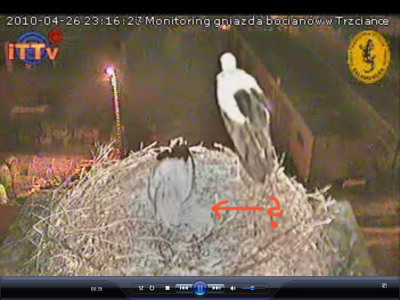

White Storks
All about amazing storks!
See them LIVE!
To watch the live cam video of a couple of nesting storks in Poland (the female already laid an egg 2 days ago!!!!), click on the picture below (be patient while it loads):
... and then return to this webpage to learn some cool facts about White Storks in Poland and to learn how long time you have to wait to see the stork chicks hatch. The female should lay another egg today or tomorrow, so keep an eye on the video! (April 28th, 2010).
Copyright A. Kepel PTOP Salamandra Poland
What is a white stork?
The white stork is a huge bird, 100-125 cm (40-50 in.) tall, with a 155-200 cm (61-79 in) wingspan. These storks weight between 2.3-4.5 kg (5-10 lbs). It is completely white except for the black wing flight feathers and its red bill and legs, which are black on the young ones. It walks slowly and steadily on the ground. Like all storks with the exception of the Leptoptilos genus, it flies with its neck outstretched.
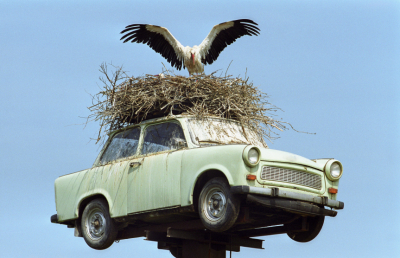
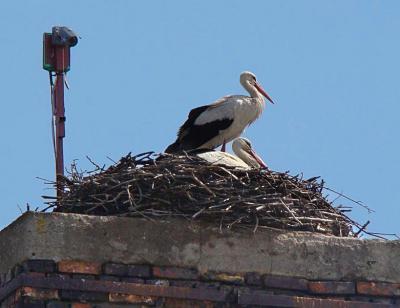
Copyright PTOP Salamandra
The white plumage of the head, neck, and body contrasts with the black wing feathers highlighted with a sheen of purple and green iridescence. A small patch of bare black skin surrounds their brown eyes. Sexes are similar in appearance, though males are slightly larger.
Do you know what storks eat?
White Storks have on their menu all sorts of prey items: snakes, lizards, all sorts of insects, mollusks, fish, crustaceans, frogs, toads, tadpoles, rodents, earthworms and mollusks.
Sometimes (but not often), storks may eat the eggs or even the chicks found in ground nesting birds.

Yummy!
The White Storks in Poland
The White storks in Europe mostly breed in Central and Eastern Europe. Poland has over 52,500 pairs of storks. Poland alone is the only country that has a 25% of all the stork population in Europe. Every year 41 thousand stork couples, out of 160 thousand living all over the world, come to Poland. Thus, every fourth stork is Polish! Most of them live by rivers and lakes in Warmia, Mazury Lake District and Podlasie - east of the country. Last year's record goes to Zywkowo village in the Mazury Lake District, where 45 couples of white storks decided to set for the summer and the autumn. Since the village was open to tourists in 1999, the place has been visited by about 2 thousand people from all over the world.
The majority of so called "stork villages", which are villages with more than 10 stork nests, can be found in the Northeast part of Poland. In the Southern Podlasie there are over 1300 stork nests. In Lwowiec, near Ketrzyn, there are 40 nests. In Lejdy near Bartoszyce there are 8 nests in just one farm and half of them are on the same barn!!!.
There may even be some villages with more storks than people!

Klopot, 60 km from Zielona Gora, is yet another stork village. Ornithologists question themselves why storks have chosen this little village as their habitat. Visitors to Klopot may check on the White Stork Museum, which is the only such place in Poland and one of the very few of its kind in Europe and the world.
More facts
The White Stork (Ciconia ciconia) is a large wading bird of the stork family Ciconiidae. This large bird breeds in the warmer parts of Europe (from the south of Estonia in the Baltic), the northwestern part of Africa and in the southwest part of Asia. It is a migrant bird which winters mostly in tropical Africa, all the way down to the south of South Africa and also in the Indian subcontinent.
Storks are famous worldwide because for a long time people have been saying that the storks bring the babies to the new parents. Probably this is related to the fact that White Storks have a habit of nesting on houses and churches in towns, when they can't find enough trees or platforms for building a nest with sticks. They prefer the chimneys or the roof of the houses, but this causes several problems to the people living in the houses. The nests are re-used for several decades, so with each couple of storks arriving, the birds improve the nest with hey and small branches. Also, when the eggs hatch, the feces (poo) of the birds makes it hard and heavy.
These are VERY COOL fact about stork's nests:
- Some of the nests of White Storks in Poland can weigh up to a ton! (Unfortunately, after some years this causes the chimneys and roofs to collapse!!!!)
- These nests also can be up to 2 meters in diameter and 3 meters deep!

Breeding and nesting
White Storks form loose informal colonies while breeding. Several pairs may nest closely together within sight and sound of one another while appearing completely oblivious to their neighbors. Nine pairs have shared one rooftop in Spain. Though storks form monogamous pairs for the duration of the breeding season, they do not migrate or over winter together. If the same pair reforms in successive years it is largely due to their strong attachment to their nest site.
Males usually arrive at the nest-site first. A male will greet a newly arriving female with the Head-Shaking Crouch display, as he lowers himself on the nest into the incubating posture, erects his neck ruff and shakes his head from side to side. If the male accepts the new arrival as his mate they will cement their pair bond with an Up-Down display. In this display the birds hold their wings away from their sides and pump their heads up and down. This is often accompanied by bill-clattering. Shorter courtships may indicate that the male and female were paired in previous years.
Nests are huge, bulky affairs constructed of branches and sticks and lined with twigs, grasses, sod, rags, and paper. Though they may be reused year after year, breeding birds will add to the structure each season. Particularly old nests have grown to over 2 m in diameter and nearly 3 m in depth. Some nests have been in continuous use for hundreds of years. Both sexes participate in nest construction with the male bringing most of the material. Completion of the structure is often signaled by the addition of one leafy branch to the edge of the nest.
European Storks have been building their nests on man-made structures since the middle ages. They can be found on rooftops, towers, chimneys, telephone poles, walls, haystacks, and specially constructed nest towers. Many homeowners will add embellishments such as wooden wagon wheels to old chimneys to encourage storks to nest on their houses. Nests can also be found in trees, on cliff-ledges, or occasionally on the ground.
The female usually lays 3-5 eggs, more rarely up to seven. Parents share incubation duties for 33-34 days. Young chicks are covered with white down and have black bills. Both parents feed the young on the nest until they fledge at 8-9 weeks of age. Fledglings may continue to return to the nest site each evening to beg for food from their parents. Young birds reach sexual maturity in their fourth year. Banding records indicate that wild birds can live and reproduce successfully past 30 years of age.

Going back to Poland and the White Storks...
The Polish, Lithuanians and Ukrainians believe that storks bring harmony to a family on whose property they nest. The White Stork is the national bird of Lithuania and Poland. Also widespread in Poland, it was a Polish mascot at the Expo 2000 Fair in Hanover.
A Polish poet Cyprian Kamil Norwid mentioned Polish storks in his poem Moja piosenka (II) ("My Song (II)"):
"For the land where it's a great travesty
To harm a stork's nest in a pear tree,
For storks serve us all...
I am homesick, Lord!... "
Cyprian Kamil Norwid, Moja piosnka (II)
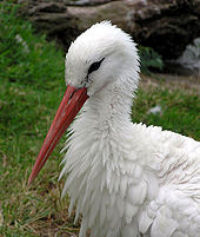
Migration
Check this map.
White Storks rely on movement between thermals of hot air for long distance flight, taking great advantage of them during annual migrations between Europe and Sub-Saharan Africa. The shortest route south would take them over the Mediterranean, but since thermals only form over land, storks take a detour. The options are limited, because to the east lies the Arabian Desert, where it is difficult to find food and water and to the west lies the Atlantic Ocean. This leaves two narrow migration corridors: eastern storks cross the straits of Bosporus to Turkey, traverse the Levant (Syria, Lebanon, Israel and Palestine), and then bypass the Sahara Desert by following the Nile, while western ones fly through the straits of Gibraltar. Either way, the storks can get help from the thermals for almost the entire trip and thus save energy.
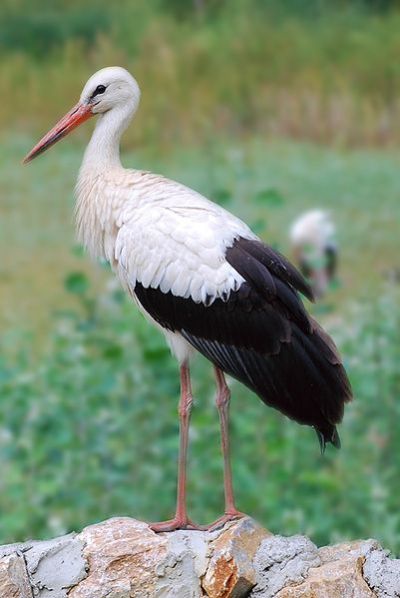
More cool facts about White Storks
Do you know that white storks can't sing?
The White Storks barely ever made any sound as a voice. In the birds world this is quite an unusual circumstances. The stork's vocal organ of a bird it's so immature that it can't produce sounds.
The white stork is almost silent except for the noisy mutual bill clattering when adults meet at the nest.
Though storks are considered to be largely silent birds, most species perform some variety of a bill-clattering display. This display reaches its most advanced form in the White Stork. They begin by throwing their heads straight back to create an amplifying resonance box in the throat pouch of the lower neck. As they clatter their upper and lower mandibles together rapidly they produce a sound very loud just like a machine gun rattle that rises and falls in pace.
In most situations throughout their lives storks do not need vocal communication at all. The storks live in open land; they are large birds of distinct colors, so they are well visible from the distance and they can find enough visual signals to maintain contact with their family members.
Only sometimes, when standing in the nest, a stork happens to "say something". Widely known is the ceremony of greeting. Its aim is to recognize partners coming back home, suppress aggression and abstain from the automatic reaction of protecting a nest from intruders.
When one stork is standing in the nest and another one flies towards it, they start the ritual of gestures with their heads, necks and wings, accompanied by long, loud clattering of beaks. Simultaneously storks produce silent sounds by letting the air go through the trachea. In most cases it is a short humming whistle or a hiss reminding a loud whisper, rarely - a hoarse purr.
Nestlings give voice more often and louder, especially when they urge their parents to feed them. Then the chicks produce sounds similar to mewing or hissing, whistle or squeal throatily and sometimes they clatter.
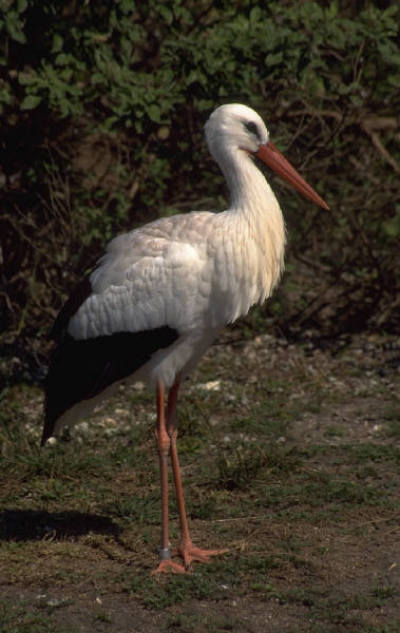
Do you know why storks don't fly over the ocean?
It is generally known that on their way to wintering sites storks fly over Turkey, Syria, Lebanon and Israel. Why don't they take a shortcut and fly over the Mediterranean, straight to the Nile? Even small birds, like flycatchers and garden warblers, do not fly round the sea, but cover great distances flying over water for several hours.
Stork's wings are built in a way, which allows them to take advantage of the streams of upward moving air. They are long and, compared to other birds, very wide (similar to these of vultures, condors, pelicans and the other close relatives of the storks).
The large wings of a stork "catch" the up going streams of the air. The storks travel like gliders, taking advantage of the air movement. However, the resistance caused by such large wings makes it impossible to flap them (Try to flap a glide!) Gliding with the wings wide spread is like "flying on the wind", because every flap of a wing takes a lot of energy and strength.
During noon and especially in sunny days, the surface of the earth warms up. The warm earth causes the air to warm up and the warm air moves upwards. If a stork finds such a stream of hot air, it can travel for hours without a single flap of wings.
It is easy to find warm air over the desert territories of Asia Minor and the Middle East. So, even if the journey is longer, it saves them a lot of energy. On the sea, there are mainly horizontal winds, so storks traveling over water are forced to flap their wings quite a lot. The storks are just not adjusted to such a way of flying. This is why the storks fly over the land. It takes longer but it saves them energy and is safer.
Written by
Ericka Ceballos
Campaigns Against the Cruelty to Animals
References
PTOP Salamandra
Smithsonian Institute
Storks Poland
Last year the Polish white storks didn't cooperate much with the nest Live Cam, so the nest remained empty.
This year the same happened, BUT luckily a school has access to a white storks nest next to one of their school windows, so they installed a video, that is working 24/7.
You can watch the family of storks live here: http://salamandra.org.pl/bocianyon-line.html
Poland has 9 hours more of difference with our time, so the best time to watch them, is before you go to sleep and when you wake up.
Enjoy it and please, share the link and tell your friends about this cool live experience!
You can help to keep us doing this high level personal and active lobbying!
Help Yupi

WAD

Ericka Ceballos is the proud Canadian Ambassador of World Animal Day. Click on the WAD logo above to check for the events that we will hold to celebrate the animals in Canada.
AD-AV Award!

Click to view larger
Campaigns Against the Cruelty to Animals


Follow us on Twitter!
Click on the button link above for important animal news, events and alerts.
Contact Info
Ericka
PO Box 16021
617 Belmont Street
New Westminster
British Columbia
V3M 6W6
Canada
Email Us!
